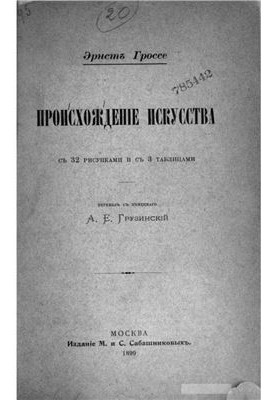Origin of Art
 Instant download
Instant download
after payment (24/7)
 Wide range of formats
Wide range of formats
(for all gadgets)
 Full book
Full book
(including for Apple and Android)
M. Published by M. and C. Sabashnikov, 1899. — VII, 293 c. The book by the German ethnographer and art critic Ernst Grosse (1862-1927) is devoted to the question of the origin of art. The author explores in detail various aspects of the artistic life of primitive peoples: sculpture and painting, music, dance, poetry; ornamentation and decoration of his own body by ancient people. He comes to the conclusion, that the forms of primitive art are subject to the same laws, who govern and the highest creations of art , It is also known as ,. that artistic activity at the lower levels of culture exists in the same forms, At higher levels (except architecture) Development of which , According to the author , The life of the hunter-gatherer. was impeded by the nomadic life of the hunter-gatherer tribes.. The main difference between primitive art and civilized Grosse sees in the fact that most of the artistic works of primitive peoples do not arise from purely aesthetic aspirations, but most often serve some practical purpose. The satisfaction of aesthetic needs in art comes to the fore only at the higher levels of civilization. The book is recommended to historians, ethnologists, art historians, cultural scientists, psychologists and sociologists, as well as anyone interested in the origin of modern art. Foreword by . The Science of Art . The method of art science . Primary peoples . Art . Cosmetics. Ornamentals. Sculpture and Painting . Dance. Poetry . Music. Conclusion
LF/301904012/R
Data sheet
- Name of the Author
- Гроссе Э.
- Language
- Russian
















